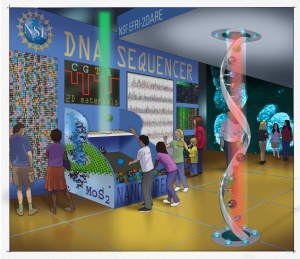Sep 25 2015
Graphene, a one-atom thick lattice of carbon atoms, has been the focus of intense research since its discovery more than a decade ago. Effectively two-dimensional, graphene has unique physical properties and ultra-high conductivity and promises to revolutionize electronic devices as the ability to mass produce it grows.
 A proposed Franklin Institute exhibit that would stem from Drndiæ's grant.
A proposed Franklin Institute exhibit that would stem from Drndiæ's grant.
However, graphene is only one member of a large family of two-dimensional material, each with its own unique and useful properties.
Now, two University of Pennsylvania nanotechnology experts have received a pair of $2 million grants to expand their graphene research into these new thin-as-possible materials.
A.T. Charlie Johnson, director of Penn’s Nano/Bio Interface Center and professor in the Department of Physics and Astronomy in Penn’s School of Arts & Sciences, and Marija Drndić, also a professor in Physics and Astronomy, are independently leading one of the 10 teams that received grants from the National Science Foundation’s Office of Emerging Frontiers in Research and Innovation.
Collaborations between these two NSF EFRI teams over the course of their four-year grants are likely.
“Penn’s strength at the intersection of nanotechnology and biology made this possible,” Johnson said. “Other groups focus on the physics and chemistry of these materials. Exploring the applications in biology and medicine is something that is not as common but where we have a wealth of talent and existing collaborations through the NBIC.”
Johnson’s grant will enable his lab to continue research on materials like molybdenum disulfide and tungsten disulfide. Like in the early days of graphene, these materials can currently only be grown in small flakes rather than more useful large sheets.
Molybdenum disulfide is of particular interest to the Johnson group’s research on nano/bio chemical sensors. By attaching biological structures, such as olfactory receptors, to graphene, they have produced devices that work like electronic noses, using the two-dimensional material’s electrical sensitivity to produce a signal when the receptor binds to its chemical target. Molybdenum disulfide’s electrical sensitivity is not as high, but, unlike graphene, it has the ability to emit light. Diagnostic devices made with molybdenum disulfide could directly indicate a binding event through a visible change in color.
Johnson’s group will collaborate with Ritesh Agarwal, Ertugrul Cubukcu and Vivek Shenoy of Penn’s School of Engineering and Applied Science on new techniques for making such devices and for reading out their activity.
Johnson and Drndić are longstanding collaborators. Beyond joint research on how the geometry of graphene’s edges impacts its overall electrical properties, the Johnson lab has provided graphene sheets that the Drndić lab has used in translocation sequencing experiments. Such studies involve drilling nanoscopic pores in the material, using its electrical sensitivity to measure the differences between genetic bases as a strand of DNA is threaded through the hole.
Drndić’s grant will extend such research beyond graphene and silicon nitride.
“We’re looking to develop new nanopores out of these novel two-dimensional materials,” Drndić said, “with the idea that graphene has some disadvantages when it comes to translocation. These new materials have interesting electrical and optical properties that might be advantageous.”
Along with a team of collaborators from Rensselaer Polytechnic Institute, Rochester Institute of Technology, Pennsylvania State University and Northeastern University, Drndić’s group will begin honing techniques for fashioning nanopores out of these new materials and then will begin testing their properties.
“This wouldn’t just be for sequencing DNA but for filtering particles and other biotechnological applications,” Drndić said.
Drndić and her graduate students will be collaborating on outreach with Philadelphia's Franklin Institute through participation in Portal to the Public, a nationwide program supported by NSF that equips researchers to be effective science communicators in informal settings. As part of this initiative, Drndić 's group will work with University of the Arts professor Slavko Milekic on the development of a portable interactive exhibit kiosk, for display at the Franklin Institute, the Philadelphia Science Festival, local schools and other venues throughout the region.